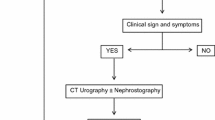Abstract
Purpose
Define factors for proper diagnosis and treatment of small intestinal injury during procedures with percutaneous renal access, thus optimizing favorable outcomes and avoiding complications and death during conservative or surgical approaches.
Materials and methods
Bibliographic review of case reports available in the literature and presentation of data from an additional case have been carried out.
Results
Percutaneous nephrolithotripsy was the procedure that most frequently caused injury of the small intestine. Time for diagnosis of the lesion took up to 5 days after the intraoperative phase. When occurring in the intraoperative phase, perforation was identified by direct endoscopic visualization; a catheter was then placed inside the intestinal lumen and a conservative approach to the derived fistula was adopted, which led to successful outcomes in all cases. Abdominal pain was the most common symptom in cases diagnosed during the postoperative phase (75%). In the presence of signs of peritonitis, surgical intervention was performed, with favorable evolution in all cases.
Conclusions
Conservative management of small intestine injuries is possible when there is no peritoneal contamination. Its success factors include intraoperative diagnosis and non-transfixing lesions, which is more common in duodenal involvement. Laparotomy to clean the cavity associated with a corrective approach (enterorrhaphy or enterectomy with primary anastomosis) was successfully indicated in cases of late diagnosis with signs of peritonitis, a situation that is most commonly found in transfixing lesions of ileum and jejunum.
Similar content being viewed by others
References
Netto NR Jr, Lemos GC, Palma PC (1988) Staghorn calculi: percutaneous versus anatrophic nephrolithotomy. Eur Urol 15(1–2):9–12
Fernstrom I, Johansson B (1976) Percutaneous pyelolithotomy: a new extraction technique. Scand J Urol Nephrol 10:257–259
Michel MS, Trojan L, Rassweiler JJ (2007) Complications in percutaneous nephrolithotomy. Eur Urol 51:899–906
Kontothanassis D, Bissas A (1997) Biliary peritonitis complicating percutaneous nephrostomy. Int Urol Nephrol 29:529–531
Sacha K, Szewczyk W, Bar K (1996) Massive haemorrhage presenting as a complication after percutaneous nephrolithotomy (PCNL). Int Urol Nephrol 28:315–318
Kondás J, Szentgyörgyi E, Váczi L et al (1994) Splenic injury: a rare complication of percutaneous nephrolithotomy. Int Urol Nephrol 26:399–404
Al-Kohlany KM, Telha KA, Al-Lahabi N (2017) Jejunal injury as a rare complication of percutaneous nephrolithotomy: case report. J Endourol Case Rep 3(1):70–73
Al-Assiri, Binsaleh S, Libman J (2005) Jejunal perforation during percutaneous nephrolithotrypsy. Sci World J 5:496–499
Begliomini H, Mattos D (2002) Bowel perforation during percutaneous renal surgery. Int Braz J Urol 28(6):533–535
Kumas A, Kumar Banerjee G, Tewari A (1994) Isolated duodenal injury during relook percutaneous nephrolithotomy. Br J Urol 74:382–383
Ahmed M, Reeve R (1995) Iatrogenic duodeno-cutaneous fistula at percutaneous nephrolithotomy managed conservatively. Br J Urol 75:416–418
Santiago L, Bellman GC, Murphy J (1998) Small bowel and splenic injury during percutaneous renal surgery. J Urol 159(6):2071–2072
Culkin DJ, Wheeler JS Jr, Canning JR (1985) Nephro-duodenal fistula: a complication of percutaneous nephrolithotomy. J Urol 134(3):528–530
Saad KS, Hanno A, El-Nahas AR (2014) Injury of the ileum during percutaneous nephrolithotomy in a pediatric patient. Can Urol Assoc J 8(3–4):E204–E206
Viville C, Garbit JL, Firmin F (1995) Les perforations digestives dans la chirurgie percutanée du rein. Ann Urol (Paris) 29:11–14
Winer AG, Hyams ES, Shah O (2009) Small bowel injury during percutaneous nephrostomy tube placement causing small bowel obstruction. Can J Urol 16(6):4950–4952
Oztürk H, Onen A, Otçu S (2003) Diagnostic delay increases morbidity in children with gastrointestinal perforation from blunt abdominal trauma. Surg Today 33(3):178–182
Tuttle DN, Yeh BM, Meng MV et al (2005) Risk of injury to adjacent organs with lower pole fluoroscopically guided percutaneous nephrostomy: evaluation with prone, supine and multiplanar reformmated CT. J Vasc Interv Radiol 16:1489–1492
Hopper KD, Sherman JL, Luethke JM (1987) The retrorenal colon in the supine and prone patient. Radiology 162(2):443–446
Osman M, Wendt-Nordahl G, Heger K et al (2005) Percutaneous nephrolithotomy with ultrasonography-guided renal access: experience from over 300 cases. BJU Int 96:875–878
de La Rosette J, Assimos D, Desai M et al (2011) The clinical research office of the endourological society percutaneous nephrolithotomy global study: indications, complications, and outcomes in 5803 patients. J Endourol 25:11–17
Labate G, Modi P, Timoney A et al (2011) The percutaneous nephrolithotomy global study: classification of complications. J Endourol 25:1275–1280
Simpson R, Martin R (1986) Use of a controlled fistula in the management of a major duodenal injury. Aust NZ Surg 56:167
Maghsoudi R, Etemadian M, Kashi AH (2017) Management of colon perforation during percutaneous nephrolithotomy: 12 years of experience in a referral center. J Endourol 31(10):1032–1036
Funding
The authors did not receive support from any organization for the work submitted.
Author information
Authors and Affiliations
Corresponding author
Ethics declarations
Conflict of interest
The authors have no conflicts of interest to declare that are relevant to the content of this article.
Additional information
Publisher's Note
Springer Nature remains neutral with regard to jurisdictional claims in published maps and institutional affiliations.
Rights and permissions
About this article
Cite this article
Fanni, V.S.S., de Oliveira Ramos, L., Leite, M.C. et al. Diagnosis and management of small intestinal injury due to percutaneous renal access. Int Urol Nephrol 53, 869–873 (2021). https://doi.org/10.1007/s11255-020-02726-1
Received:
Accepted:
Published:
Issue Date:
DOI: https://doi.org/10.1007/s11255-020-02726-1




